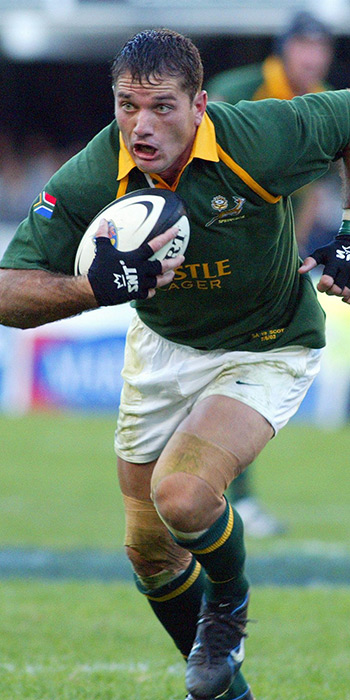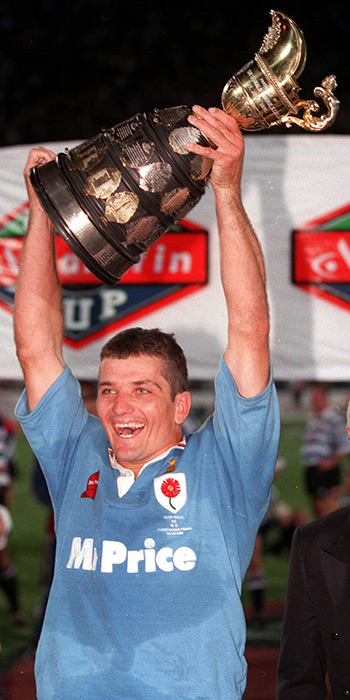Joost: The warrior who stopped Lomu
He earned it the hard way – with grace, skill, but most of all guts.
Taller and heavier than the norm for his position, the Springbok scrumhalf played with the conviction that there was never an opponent he could not beat, a try he could not score, or a tackle he could not make.
With raw courage he etched his name into the annals of World Cup finals on one afternoon – June 24, 1995.
The Springboks, having missed the first two tournaments, were playing the All Blacks, their oldest and keenest rivals, in the final at Ellis Park in Johannesburg.
In massive Jonah Lomu the All Blacks were fielding the most feared player in world rugby.
The Kiwis had swept all before them on the way to the final and none had an answer to Lomu, the runaway freight train who trampled defenders underfoot like chaff including England's vastly talented Mike Catt in the semi-final.
The question on everyone's lips was: "can the Boks stop Jonah Lomu?"
The answer came quite early in the final. Calling a blindside move, the All Blacks sent their juggernaut winger charging through a gap in the Bok defence.
It seemed the men in black would certainly score but there was one man between Lomu and the try line – Van der Westhuizen.
It seemed a most unequal contest but Van der Westhuizen, without a care for his own safety, threw himself at the All Black's tree-trunk legs, threw a vice-like grip around them, and brought the giant crashing to the ground.
Lomu had been stopped, the crisis averted and the complexion of the game had changed.
One could sense the Springboks growing in confidence as they pushed on to win the game and the Webb Ellis Cup in extra time.
That moment epitomised Van der Westhuizen. And it was his bravery that stood out most – he was always willing to put his body on the line – as summed up by a quote of his after the cup had been won and the threat of Lomu blunted.
"The difference between us and the other nations is that they were scared of Lomu, but we queued up to tackle him!"
Later came the halcyon moment when Van der Westhuizen, responding to Joel Stransky's call to overrule a planned move, set the ball spinning accurately infield to set his flyhalf up for the winning drop-goal.
Blessed with exceptional strength and pace, Van der Westhuizen was a key component in then coach Kitch Christie's plans.
It was his pace that pulled the Australian Wallabies out of alignment to set up a crucial try for Stransky in the opening game at Newlands and aficionados marvelled at the ones he scored himself.
At Murrayfield he broke clean through the Scottish pack to score and a solo effort along the touchline at Twickenham that included speed, power and deft touches was arguably the best of the 38 times he touched down behind the enemy's line.
In May 2011 came the shock news that he had been diagnosed with motor neuron disease, and that he had a life expectancy of just two to five years.
In response to becoming ill, Van der Westhuizen established the J9 Foundation, after his playing number, in aid of those suffering from the disease.
The pathos of his suffering was heart-rending; a super athlete now confined to a wheelchair, unable to speak and being fed through a tube.
Yet his determination, guts and humour shone through.
"I'm not pissed [drunk], I just speak like this now," he quipped at a benefit banquet to explain his slurred speech.
Many former internationals rate the Springbok standout second only to former Welsh great Gareth Edwards among international scrumhalf superstars.
His duels with fellow scrumhalves George Gregan of Australia and Justin Marshall of New Zealand two decades ago captivated spectators and worldwide TV audiences.
"He will always be remembered as an incredible rugby player," Gregan said during a dinner in honour of Van der Westhuizen.
Marshall also attended the function and said: "Joost was a magic player. When on song, he could win a game almost single-handedly." 
When the Springboks gathered in 2015 at Ellis Park to celebrate the 20th anniversary of the World Cup triumph, Van der Westhuizen attended in a wheelchair.
Van der Westhuizen was also part of the Springboks team that finished third when defending the world title in England four years later.
His Test career ended on a low note in 2003 when a South African team beset by pre-World Cup problems lost heavily to New Zealand in the quarterfinals.
First capped by the Springboks in 1993, he made 89 international appearances and scored 38 tries, a remarkable total for a scrumhalf.
Traditionally, the role of a No.9 was to feed scrums and forage for the ball at rucks, mauls and loose play, then pass it to his flyhalf.
But Van der Westhuizen, tall and dark haired with matinee-idol looks, helped create a new breed of scrum-halves who greatly expanded the role.
"An incredible player and fighter to the end. The first of the new age No.9's," tweeted Ireland and British and Irish Lions legend Brian O'Driscoll.
Instead of always feeding the flyhalf, the Springbok would launch solo raids, catching defences off guard.
Blessed with a strong physique, Joost was able to shrug off would-be tacklers and many of his Test tries came off runs from deep positions.
He was a product of the famed Pretoria-based Blue Bulls, a team that for decades had been among the dominant forces of South African provincial rugby.
When Van der Westhuizen felt a weakness in his right arm during 2008, he attributed it to the after-effects of an old rugby injury.
But later, while playing in a swimming pool with his personal doctor, the weakness became more obvious.
The doctor suspected motor neuron disease – a devastating diagnosis that was confirmed by specialists.
Van der Westhuizen was given five years to live, and fought the increasingly debilitating disease with a bravery that touched South Africans.
Van der Westhuizen won thousands of admirers with a new-found humility.
Apart from fighting the incurable disease, Van der Westhuizen created a foundation to help fellow sufferers.
Although confined to a wheelchair, he travelled to the United States and Britain to highlight the disease and take part in various trials as doctors sought a cure.
Agence France-Presse















































